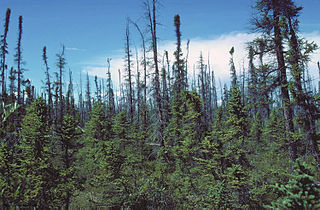
The Labrador duck was a North American bird; it has the distinction of being the first endemic North American bird species to become extinct after the Columbian Exchange, with the last known sighting occurring in 1878 in Elmira, New York. It was already a rare duck before European settlers arrived, and as a result of its rarity, information on the Labrador duck is not abundant, although some, such as its habitat, characteristics, dietary habits and reasons behind its extinction, are known. There are 55 specimens of the Labrador duck preserved in museum collections worldwide.

The sea ducks (Mergini) are a tribe of the duck subfamily of birds, the Anatinae. The taxonomy of this group is incomplete. Some authorities separate the group as a subfamily, while others remove some genera. Most species within the group spend their winters near coastal waters. Many species have developed specialized salt glands to allow them to tolerate salt water, but these are poorly developed in juveniles. Some of the species prefer riverine habitats. All but two of the 22 species in this group live in far northern latitudes.

The white-throated sparrow is a passerine bird of the New World sparrow family Passerellidae.

The white-crowned sparrow is a species of passerine bird native to North America. A medium-sized member of the New World sparrow family, this species is marked by a grey face and black and white streaking on the upper head. It breeds in brushy areas in the taiga and tundra of the northernmost parts of the continent and in the Rocky Mountains and Pacific coast. While southerly populations in the Rocky Mountains and coast are largely resident, the breeding populations of the northerly part of its range are migratory and can be found as wintering or passage visitors through most of North America south to central Mexico.

The golden-crowned sparrow is a large New World sparrow found in the western part of North America.

Harris's sparrow is a large sparrow. Their breeding habitat is the north part of central Canada, making it Canada's only endemic breeding bird. In the winter they migrate to the Great Plains states of the United States, from southern South Dakota to central Texas. The common name of this species commemorates the American amateur ornithologist Edward Harris (1799–1863).

The rufous-collared sparrow or Andean sparrow is an American sparrow found in a wide range of habitats, often near humans, from the extreme south-east of Mexico to Tierra del Fuego, and in the Caribbean. It has diverse vocalizations, which have been intensely studied since the 1970s, particularly by Paul Handford and Stephen C. Lougheed (UWO), Fernando Nottebohm and Pablo Luis Tubaro (UBA). Local names for this bird include the Portuguese tico-tico, the Spanish copetón ("tufted") in Colombia, as well as chingolo and chincol, and comemaíz "corn eater" in Costa Rica.

The boreal forest or taiga of the North American continent stretches through a majority of Canada and most of central Alaska, extending spottily into the beginning of the Rocky Mountain range in Northern Montana and into New England and the Adirondack Mountains of New York. This habitat extends as far north as the tree line and discontinues in mixed deciduous-coniferous forests to the south. The "taiga", as it is called there, of Eurasia occupies a similar range on those continents. Throughout the Northern Hemisphere, the boreal forest covers 2.3 million square miles, a larger area than the remaining Brazilian Amazon rain forest. Although it is largely forest, the boreal forests include a network of lakes, river valleys, wetlands, peat lands and semi-open tundra.
Dr. Elizabeth Derryberry is an associate professor in the Department of Ecology and Environmental Biology in the College of Arts and Sciences at the University of Tennessee who specializes in ornithology.










